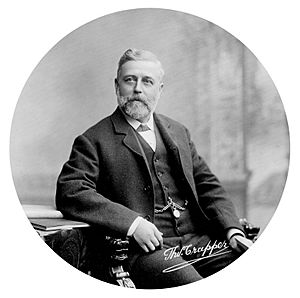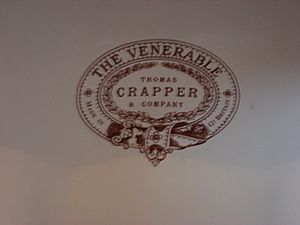Thomas Crapper facts for kids
Quick facts for kids
Thomas Crapper
|
|
|---|---|
 |
|
| Born | 28 September 1836 Waterside, Thorne, Yorkshire, England, United Kingdom
|
| Died | 27 January 1910 (aged 73) |
| Occupation | Businessman, plumber |
| Spouse(s) | Maria Green (1837–1902) |
| Parent(s) | Charles Crapper |
Thomas Crapper (born 1836, died 1910) was a famous English businessman and plumber. He started his own company, Thomas Crapper & Co, in London. This company made equipment for bathrooms and toilets.
Crapper held nine patents for his inventions. Three of these were for making toilets better, like the floating ballcock part. He also improved the S-bend plumbing trap in 1880 by inventing the U-bend. His company had the world's first showroom for baths, toilets, and sinks. Thomas Crapper was known for making very good quality products. He even received special awards called royal warrants.
Today, you can still see manhole covers with Crapper's company name on them near Westminster Abbey in London. These have become a small tourist attraction!
Contents
Early Life and Business
Thomas Crapper was born in Thorne, England, in 1836. We don't know his exact birthday, but he was baptised on September 28, 1836. His father, Charles, worked as a sailor.
In 1853, when Thomas was about 17, he started learning to be a plumber. He worked for his brother George, who was a master plumber in Chelsea. After three years, Thomas became a skilled plumber himself.
In 1861, Crapper decided to start his own business. He became a "sanitary engineer." This meant he designed and installed plumbing systems. He even had his own workshops where he made metal parts for plumbing.
In the 1880s, Prince Albert (who later became King Edward VII) bought a large country house called Sandringham House. He asked Thomas Crapper & Co. to install all the plumbing there. This included thirty toilets with fancy cedarwood seats. This was a big deal for Crapper. It earned him his first Royal Warrant. This award meant his company was trusted by the royal family. His company received more royal warrants from King Edward and King George V.
Thomas Crapper retired in 1904. He passed his company on to his nephew George and his business partner, Robert Marr Wharam. Crapper lived in Anerley for the last six years of his life. He died on January 27, 1910, and was buried in Elmers End Cemetery.
What Happened to the Crapper Company?
In 1966, the Crapper company was sold to another company called John Bolding & Sons. This happened when the owner, Robert G. Wharam (Robert Marr Wharam's son), retired. However, Bolding & Sons closed down in 1969.
The Crapper company name wasn't used for a while. Then, a historian named Simon Kirby bought it. He collected old bathroom items. Simon Kirby brought the company back to life in Stratford-upon-Avon. Now, the company makes new versions of Crapper's original Victorian bathroom fittings.
Crapper's Plumbing Improvements
Thomas Crapper was the first person to open public showrooms for bathroom items. This made him famous for promoting good plumbing. He helped make it popular for people to have proper plumbing inside their homes. He also worked to make existing plumbing and bathroom parts better. Because he had his own workshop, he could try out new ideas and create more effective plumbing solutions.
In 1880, Crapper improved the S-bend trap. This part of a drain stops bad smells from coming up. His new U-bend plumbing trap was much better than the S-bend. It didn't get stuck easily. Also, unlike the S-bend, it didn't dry out, so it didn't need an overflow pipe. The BBC even called the S-bend one of the "50 Things That Made the Modern Economy."
Crapper held nine patents for his inventions. Three of these were for making toilets better, like the floating ballcock. However, he did not invent the flush toilet itself.
Crapper's advertisements sometimes suggested he invented the siphonic flush. One ad said "Crapper's Valveless Water Waste Preventer (Patent #4,990)." But this patent was actually for a small improvement made by Albert Giblin in 1898. However, Crapper's nephew, George, did improve the siphon system that starts the water flow in a toilet. He received a patent for this in 1897.
The Word "Crap"
Many people think the slang word "crap" (meaning human waste) came from Thomas Crapper. They often say that American soldiers in England during World War I saw his name on toilets. Then, they started using "crapper" as slang for a toilet.
However, the word "crap" is actually much older. It comes from the Middle English language. It probably came from two older words: the Dutch word krappen (meaning to pluck or cut off) and the Old French word crappe (meaning waste or rejected material).
In English, "crap" first meant things like leftover husks or weeds. The first time it was used to mean bodily waste was in 1846. This was 10 years after Thomas Crapper was born. It was used in a phrase like "crapping ken," which meant a toilet house.




